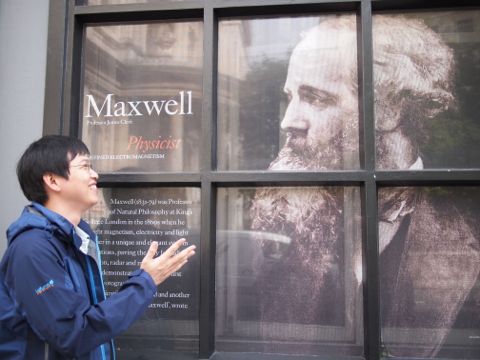Wonseok Shin, Ph.D.
 |
Photo: An encounter with James Clerk Maxwell at King's College London, September 2013. Click here to see my efficient ways of solving his equations in the frequency domain.
|
What's New
(Jul 15, 2019) I have been working at MIT Lincoln Laboratory as a Technical Staff (Ph.D. position) for more than 6 months now, and I am enjoying the R&D here. My MIT email address is still effective, so please use it if you need to contact me.
(Nov 1, 2018) I am going to leave MIT in about 1 month. (The destination will be announced here later.) If you have anything to discuss while I am at MIT, please contact me sooner than later.
(Mar 6, 2017) I participated in designing a ultrathin, subwavelength spectral light separator. This image sensor device captures three different wavelengths within a 50nm-thick pixel efficiently over a wide range of incidence angles.
(Oct 25, 2016) I co-developed a new computational electromagnetics method for simulating multi-time-scale phenomena. To simulate phenomena involving vastly different frequencies (e.g., GHz modulation of THz signals), time-domain methods require a huge number of time steps (to simulate slow frequencies) with very fine step size (to resolve fast frequencies), so they take very long simulation time. On the other hand, conventiontal frequency-domain methods find the steady-state solution directly, but they can handle only one frequency at a time. Our new frequency-domain method is able to find the steady-state solution involving multiple frequencies, so it overcomes the limitations of both the conventional time- and frequency-domain methods.
(Jun 21, 2016) I helped designing microfluidic channels with optical trap-and-release mechanism.
(Oct 26, 2015) My detailed analysis of the behavior of the Ohmic loss rates in metallic slot waveguides is published. The analysis reveals that the Ohmic loss rates of microwave signals are plateaued at a material- and shape-independent value before reaching the theoretical maximum typically attainable by optical signals. The plateau explains why microwave signals have negligible Ohmic loss compared to optical signals.
(Sep 01, 2015) I start as an Applied Mathematics Instructor and Postdoctoral Associate at MIT.
Current Appointments
Applied Mathematics Instructor in the Department of Mathematics at MIT
Postdoctoral Associate in Prof. Steven G. Johnson's group at MIT
Education
Ph.D. in Electrical Engineering, Stanford University, 2013 (advisor: Prof. Shanhui Fan)
M.S. in Electrical Engineering, Stanford University, 2007
B.S. in Physics & Mathematics, Seoul National University, 2001
Contact
Room 8-311, Massachusetts Institute of Technology
77 Massachusetts Avenue
Cambridge, MA 02139, USA
e-mail: wsshin ατ mit δοτ edu